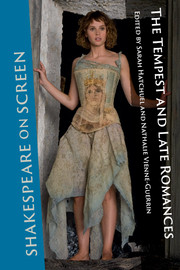Book contents
- Shakespeare on ScreenThe Tempest and Late Romances
- Series page
- Shakespeare on Screen
- Copyright page
- Dedication
- Contents
- Illustrations
- Contributors
- Series Editors’ Preface
- Acknowledgements
- Chapter 1 Introduction
- Chapter 2 Thanhouser's ‘Fierce Abridgement’ of Cymbeline
- Chapter 3 Looking (at) Women in the BBC Pericles
- Chapter 4 Scenes from Cymbeline and Early Television Studio Drama
- Chapter 5 Romance for Television
- Chapter 6 The Winter's Tale
- Chapter 7 The Winter's Tale's Spectral Endings
- Chapter 8 Shakespeare's Puppets
- Chapter 9 ‘Something Rich and Strange’
- Chapter 10 The Absent Masque in Three Films of The Tempest
- Chapter 11 Prospero's Books
- Chapter 12 The Alternating Utopic Revisions of The Tempest on Film
- Chapter 13 Screen Magic in Greenaway's Prospero's Books and Taymor's The Tempest
- Chapter 14 Almereyda's Cymbeline
- Chapter 15 Ghost Towns and Alien Planets
- Chapter 16 Grafting The Tempest onto Allégret's Le Bal du Comte d'Orgel
- Chapter 17 The Romances on Screen
- Index
- References
Chapter 17 - The Romances on Screen
Select Film Bibliography
Published online by Cambridge University Press: 16 June 2017
- Shakespeare on ScreenThe Tempest and Late Romances
- Series page
- Shakespeare on Screen
- Copyright page
- Dedication
- Contents
- Illustrations
- Contributors
- Series Editors’ Preface
- Acknowledgements
- Chapter 1 Introduction
- Chapter 2 Thanhouser's ‘Fierce Abridgement’ of Cymbeline
- Chapter 3 Looking (at) Women in the BBC Pericles
- Chapter 4 Scenes from Cymbeline and Early Television Studio Drama
- Chapter 5 Romance for Television
- Chapter 6 The Winter's Tale
- Chapter 7 The Winter's Tale's Spectral Endings
- Chapter 8 Shakespeare's Puppets
- Chapter 9 ‘Something Rich and Strange’
- Chapter 10 The Absent Masque in Three Films of The Tempest
- Chapter 11 Prospero's Books
- Chapter 12 The Alternating Utopic Revisions of The Tempest on Film
- Chapter 13 Screen Magic in Greenaway's Prospero's Books and Taymor's The Tempest
- Chapter 14 Almereyda's Cymbeline
- Chapter 15 Ghost Towns and Alien Planets
- Chapter 16 Grafting The Tempest onto Allégret's Le Bal du Comte d'Orgel
- Chapter 17 The Romances on Screen
- Index
- References
- Type
- Chapter
- Information
- Shakespeare on Screen<I>The Tempest</I> and Late Romances, pp. 283 - 303Publisher: Cambridge University PressPrint publication year: 2017



